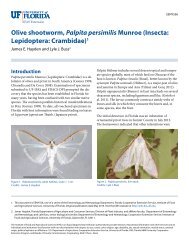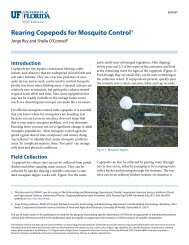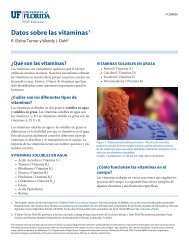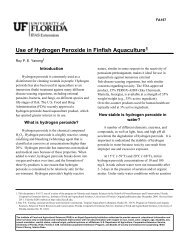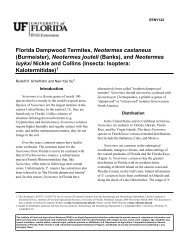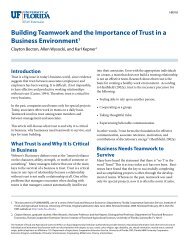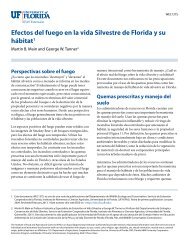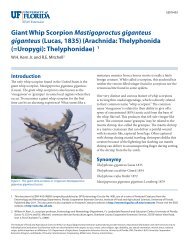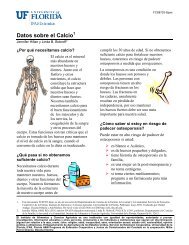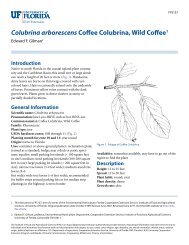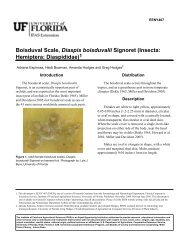Puss Caterpillar (Larva), Southern Flannel Moth (Adult ...
Puss Caterpillar (Larva), Southern Flannel Moth (Adult ...
Puss Caterpillar (Larva), Southern Flannel Moth (Adult ...
Create successful ePaper yourself
Turn your PDF publications into a flip-book with our unique Google optimized e-Paper software.
in the Megalopyge cocoon are often, but not always chewed<br />
through the operculum.<br />
Figure 36. Megalopyge opercularis cocoon with ichneumonid larva -<br />
probably Lanugo retentor.<br />
Credits: Donald W. Hall, University of Florida.<br />
Figure 37. Megalopyge opercularis cocoon with exit hole in operculum<br />
probably made by the ichneumonid Lanugo retentor.<br />
Credits: Donald W. Hall, University of Florida.<br />
Khalaf (1975) reported a parasitization rate of 50% by<br />
Lanugo retentor in a population of Megalopyge opercularis<br />
in New Orleans, Louisiana.<br />
Control<br />
In most years, puss caterpillars are kept under control by<br />
natural enemies. If control measures are required, chemical<br />
insecticide or Bacillus thuringiensis applications recommended<br />
for control of other caterpillars (Osborne et al.<br />
2012) should be effective.<br />
Cocoon Guests<br />
A wide variety of insects use the old abandoned cocoons as<br />
homes or temporary shelters - either entering through the<br />
front as the opercula sag with age or through the exit holes<br />
chewed by ichneumonid parasitoids. Two species of ants<br />
have even been found raising brood inside the cocoons.<br />
Spiders are also common inhabitants of old cocoons.<br />
Figure 38. Pseudomyrmex gracilis (Fabricius) and brood inside old<br />
Megalopyge opercularis cocoon.<br />
Credits: Donald W. Hall, University of Florida.<br />
Figure 39. Crematogaster ashmeadi Mayr and brood inside old<br />
Megalopyge opercularis cocoon.<br />
Credits: Donald W. Hall, University of Florida.<br />
Figure 40. Camponotus snellingi Bolton and unidentified tachinid<br />
puparial shell inside old Megalopyge opercularis cocoon.<br />
Credits: Donald W. Hall, University of Florida.<br />
10



